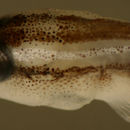en
names in breadcrumbs


Diagnosis: Fused pelvic fins and modal fin-ray counts of D-VII,12 A-11 and Pect-16-17 indicate some of the cleaner gobies of the genus Elacatinus (formerly considered Gobiosoma). The common cleaner goby in Panama is E. illecebrosus, a bar-nosed species from the south-western Caribbean.
Analogues: (ventral midline series x3: thorax, anal fin, caudal peduncle streak) Larval cleaner gobies share this melanophore pattern with several congeners: T. saucrus and T. dilepis larvae have D-11 A-10 and a smaller eye; T. multifasciatus have D-11 A-10, a shorter cup-shaped pelvic fin, usually less than half-way to the vent, and 20-21 pectoral-fin rays. Larval cleaner gobies and congeners can be separated from the very common six-spined gobies with the same VMSx3 melanophore pattern primarily by the length of the caudal peduncle streak. Most larval Coryphopterus and Lythrypnus (all six-spined) have their caudal peduncle streak extending to the start of the procurrent caudal-fin rays vs. about half-way for the seven-spined gobies. Many of those six-spined species also have a prominent melanophore at the corner of the jaw, absent on the seven-spined larvae. Also distinctive is the large cup-shaped pelvic fin on larval cleaner gobies; the six-spined gobies tend to have flat pelvic fins. Larvae of the cleaner gobies are likely identical, but recruits and juveniles of E. illecebrosus are separated from the other bar-nosed species by having a wide-oval or wedge-shaped pale area on top of the snout (not uniformly linear as in E. randalli, E. colini, E. xanthiprora, and E. lori) and a mostly dark area from the eye forward to the upper jaw (vs. pale in E. randalli and E. colini).
Description: Body thin, long, and narrow with a large eye and a terminal, medium-sized mouth. Pectoral fins long, reaching to vent, pelvic fins long and form a large obvious cup extending about two-thirds of the way to the vent. Dorsal and anal fins relatively short, caudal peduncle long and narrow, tapering rapidly and at the narrowest point, typically only about the eye-diameter in width, procurrent caudal-fin rays 6-8 (6-7 spindly). Lightly marked along the lower body: melanophores along the ventral midline at the isthmus (sometimes missing) and the pelvic-fin insertion, then along the anal-fin base (variable number, often only two or three) and as a streak along the ventral caudal peduncle, stopping well before the procurrent caudal-fin rays. Internal melanophores at the dorsal surface of the swim bladder and sometimes around the gut near the vent. Transitional recruits develop two wide dark stripes along the top of the head separated by a thin clear line. The stripes meet behind the head and extend along the base of the dorsal fin fading out before the caudal peduncle. The head stripes extend forward onto the snout encircling a median white bar that is distinctly oval, diamond- or wedge-shaped. The dark area surrounding the bar is uniform, not simply outlining the bar, and covers most of the area between the eye and the upper jaw, extending broadly onto the upper lip. Below the dorsal midline stripe is a prominent lateral clear band outlining a white iridescent stripe, blue (or yellow) in life, running from the dorsal aspect of the eyeball back to the upper tail. Below the light band there is a wide dark stripe running from the eye along the body just below the lateral midline to the caudal fin, widening at the caudal-fin base and then extending out along the lower central caudal-fin rays. Deep to this surface stripe is a broad streak of internal melanophores extending above and below the lateral midline.